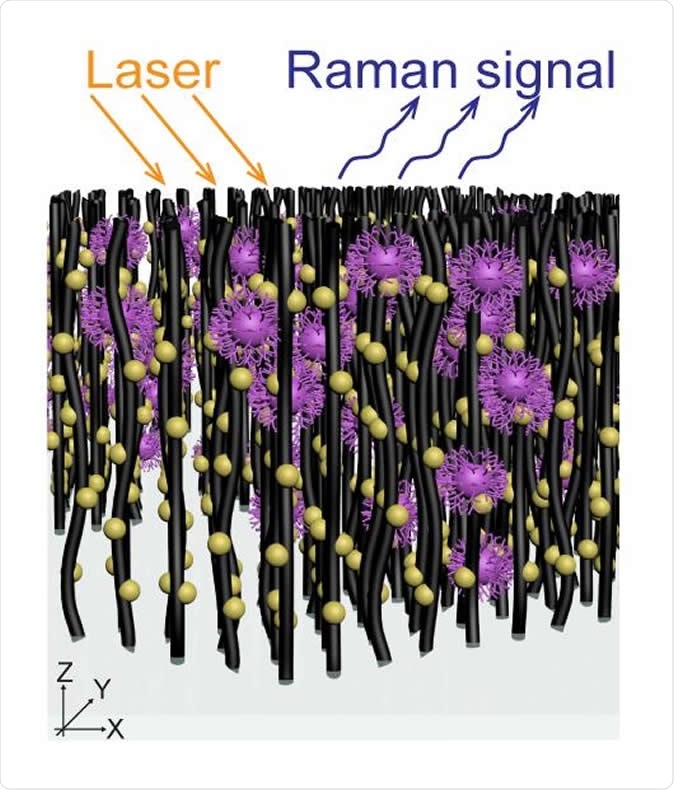A new study published in the journal Proceedings of the National Academy of Sciences on December 23, 2019, describes a novel device developed by a team of researchers at Penn State and New York University. Not only can this instrument capture different types of virus, it can tell what kind they are.
Viruses spreading from animals to humans
There are about 1.7 million viruses still unknown to scientists today but living in animals. These zoonotic viruses can, in several cases, be transmitted to humans. This includes familiar viruses like the Zika, H5N1 and Ebola viruses, that are capable of causing death and rampaging illness across entire country sides unless quickly and effectively contained. The World Health Organization also supports early detection as a way to limit the spread of such viruses from the infected patients, since once detected these patients can be put under infection containment measures immediately.
Older work by some of the same researchers has led to the use of the CNT-STEM, a microdevice based on vertical arrays of carefully doped multiwalled carbon nanotubes, whose size can be adjusted as required to capture a range of viruses based on their size, from 17 to 325 nm. It is designed to enrich any sample for viral detection from field samples. This device was found to increase the detection rate as well as the rates of viral isolation a 100-fold. This was in addition to removing contaminant particles and concentrating the sample so that the presence of any virus could be directly identified.
In fact, this early device helped the researchers pick up an emerging avian influenza virus as well as a new strain of the virus.
The VIRRION
The new device, called a VIRRION, is both small and inexpensive, designed to be held in the hand while looking for viruses by size. Researcher Mauricio Terrones says, “Our device uses arrays of nanotubes engineered to be comparable in size to a wide range of viruses. We then use Raman spectroscopy to identify the viruses based on their individual vibration.”

This is an array of nanotubes decorated with gold nanoparticles captures virus molecules. Image Credit: Terrones Lab/Penn State
They used carbon nanotubes arranged in a gradient of size, in the form of a vertically aligned forest array. This served as a filter to catch different viruses, depending on how large they are. These viruses are then subjected to in situ Raman spectroscopy. The concept was captured in a hand-held device.
The VIRRION allows any sample containing viruses – whether from a patient or from the environment – to be rapidly enriched to increase the number of viral particles. It is able to increase the concentrations of virus particles in just a small sample – a few millilitres – of clinical matter and takes only minutes to do so. As a result, the process of characterizing the viruses becomes much faster.
Besides the rapid speed of processing, the compact profile and low cost of the equipment contrast favourably with the large bulk and high cost of currently available devices. The designers explain its advantageous build features: “The VIRRION is a few centimeters across. We add gold nanoparticles to enhance the Raman signal so that we are able to detect the virus molecule in very low concentrations. We then use machine learning techniques to create a library of virus types.”
Applications
The VIRRION could have a range of applications, from detecting plant viruses early in a field of crops to detection of viruses in human beings within minutes as opposed to days. In the first case, such a possibility could save whole crops from destruction by viral infection. In livestock herds too, culling and wholesale slaughter could be averted if viral detection were possible in the early stages of infection, before it spreads to the whole herd. In human beings, finding the presence of a virus could help avoid epidemics and even endemic infections by enabling rapid containment measures to be put into place.
Such cost-effective and portable equipment could also facilitate medical consultations, both in personal visits as well as from remote locations that are the site of viral outbreaks.
Moreover, from the academic and medical point of view, the speed of enrichment and viral detection could help capture the time of emergence of a new virus, as well as helping to discover new viruses and to diagnose viral infection.
Says virologist Elodie Ghedin, “Eventually, we hope to use this device for the capture and sequencing of single virions, giving us a much better handle on the evolution of the virus in real time.”
Journal reference:
A rapid and label-free platform for virus capture and identification from clinical samples, Proceedings of the National Academy of Sciences, Ying-Ting Yeh,Kristen Gulino, Tsui-Wen Chou, Bin Zhou, YuHe Zhang, Aswathy Sabestien, Zhong Lin, Istvan Albert, Huaguang Lu and Venkataranman Swaminathan, 10.1073/pnas.1910113117